Chapter: Artificial Intelligence(AI) : Knowledge Inference
KR Using Predicate Logic
KR Using Predicate Logic
In the previous section much has been illustrated about knowledge and KR related issues. This section, illustrates :
How knowledge can be represented
as “symbol
structures” that
characterize bits of knowledge about objects, concepts, facts, rules,
strategies;

Assumptions about KR :
Intelligent Behavior can be achieved by manipulation of symbol structures.
KR languages are designed to facilitate operations over symbol structures, have precise syntax and semantics;
Syntax tells which expression is legal
?,
e.g., red1(car1), red1 car1, car1(red1), red1(car1 & car2)
?; and
Semantic tells what an expression means ?
e.g., property “dark red” applies to my car.
Make Inferences, draw new conclusions from existing facts.
To satisfy these assumptions about
KR, we need formal notation that allow automated inference and problem solving.
One popular choice is use of logic.
Logic
Logic is concerned with the truth
of statements about the world.
Generally each statement is either TRUE or FALSE.
Logic includes : Syntax , Semantics and Inference Procedure.
Syntax :
Specifies the symbols
in the language about how they can be combined to form sentences. The facts
about the world are represented as sentences in logic.
Semantic :
Specifies how to assign a truth
value to a sentence based on its meaning in the world. It Specifies what
facts a sentence refers to.
A fact is a claim about the world,
and it may be TRUE or FALSE.
Inference Procedure :
Specifies methods
for computing new sentences from the existing sentences.
Note
Facts :
are claims about the world that are True or False. Representation : is an expression (sentence), stands for the objects and relations.
Sentences : can be encoded in a computer program.
Logic as a KR Language
Logic is a language for reasoning,
a collection of rules used while doing logical reasoning. Logic is studied as
KR languages in artificial intelligence.
◊ Logic is
a formal system in which the formulas or sentences have true or false values.
Problem of designing KR language is a tradeoff between that which is
Expressive enough to represent important objects and relations in a problem domain.
Efficient enough in reasoning and answering
questions about implicit information
in a reasonable amount of time.
Logics are of
different types : Propositional logic, Predicate
logic,
Temporal logic, Modal logic, Description logic etc;
They represent things and allow
more or less efficient inference.
Propositional logic and Predicate logic are fundamental to all
logic.
Propositional Logic is the study of statements and their connectivity. Predicate Logic is the study of
individuals and their properties.
1. Logic Representation
Logic can be used to represent
simple facts.
The facts are claims about the world that are True or False.
To build a Logic-based representation :
User defines a set of primitive symbols
and the associated semantics.
Logic defines ways of putting
symbols together so that user can define legal sentences in the language that represent TRUE facts.
Logic defines ways of inferring new sentences from existing ones.
Sentences - either TRUE or false but not both are called propositions.
A declarative sentence expresses a statement
with a proposition as content; example:
the declarative "snow is white" expresses that snow is white; further, "snow is white" expresses that snow
is white is TRUE.
In this section, first Propositional Logic (PL) is briefly
explained and then the Predicate logic
is illustrated in detail.
Propositional Logic (PL)
A proposition is a statement, which
in English would be a declarative sentence. Every proposition is either TRUE or
FALSE.
Examples: (a) The sky is blue.,
(b) Snow is cold. , (c) 12 * 12=144
Propositions
are “sentences” , either true or false
but not both.
A sentence
is smallest unit in propositional logic.
‡ If
proposition is true, then truth value is
"true" .
If
proposition is false, then truth value
is "false" .
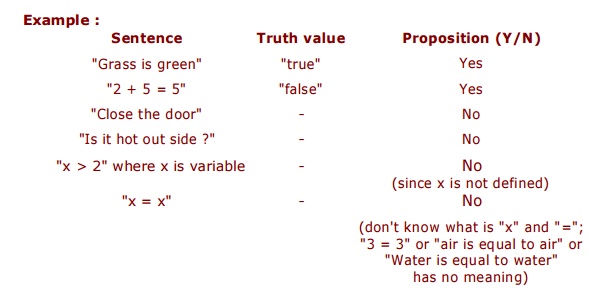
Propositional logic is fundamental to all logic.
Propositional logic is also called
Propositional calculus, Sentential calculus, or Boolean algebra.
Propositional logic tells the ways
of joining and/or modifying entire propositions, statements or sentences to
form more complicated propositions, statements or sentences, as well as the
logical relationships and properties that are derived from the methods of
combining or altering statements.
Statement, Variables and Symbols
These and few more related terms,
such as, connective, truth value, contingencies, tautologies, contradictions, antecedent, consequent,
argument are explained below.
◊ Statement
Simple statements
(sentences), TRUE or FALSE, that does not contain any other statement as a part, are basic
propositions; lower-case letters, p, q, r, are symbols for simple statements.
Large, compound or complex statement are constructed from basic propositions
by combining them with connectives.
◊ Connective or Operator
The connectives join simple statements into compounds, and joins compounds into
larger compounds.
Table below indicates, the basic connectives and their symbols :
listed in decreasing order of
operation priority;
operations with higher priority is
solved first.
Example of a formula : ((((a Λ ¬b) V c →
d) ↔
¬ (a V c ))
Connectives and Symbols in
decreasing order of operation priority
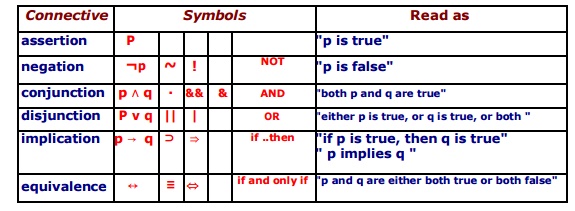
Note : The propositions and
connectives are the basic elements of propositional logic.
◊ Truth Value
The truth value of a statement is
its TRUTH
or FALSITY ,
Example : p
~p is either TRUE or FALSE, p v q is either TRUE or FALSE,
use " T " or
is either TRUE or FALSE, and so on.
1 "
to mean TRUE. use " F "
or
0 "
to mean FALSE
Truth table defining the basic
connectives :

Tautologies
A proposition that is always true
is called a "tautology".
e.g., (P v ¬P) is always true regardless of the
truth value of the proposition P.
Contradictions
A proposition that is always false
is called a "contradiction".
e.g., (P ∧ ¬P)
is always false regardless of the truth value of the proposition P.
◊ Contingencies
A proposition is called a "contingency" , if that
proposition is neither a tautology nor a
contradiction .
e.g., (P v Q) is a contingency.
Antecedent, Consequent
These two are parts of conditional
statements. In the conditional statements, p → q
, the
1st statement or "if - clause" (here p) is called antecedent ,
2nd statement or "then - clause" (here q) is called consequent.
Argument
An argument is a demonstration or a
proof of some statement. Example : "That bird is a crow;
therefore, it's black."
Any argument can be expressed as a
compound statement.
In logic, an argument is a set of
one or more meaningful declarative sentences (or "propositions")
known as the premises along with another meaningful
declarative sentence (or
"proposition") known as
the conclusion.
Premise is a proposition which gives reasons, grounds, or evidence for accepting some other proposition,
called the conclusion. Conclusion is
a proposition, which is purported to be established on the basis of other propositions.
Take all the premises, conjoin
them, and make that conjunction the antecedent of a conditional and make the
conclusion the consequent. This implication statement is called the
corresponding conditional of the argument.
Note : Every argument has a
corresponding conditional, and every implication statement has a corresponding
argument. Because the corresponding conditional of an argument is a statement,
it is therefore either a tautology, or a contradiction, or a contingency.
An argument is valid
"if and only if" its corresponding conditional is a tautology.
Two statements are consistent
"if and only if" their conjunction is not a contradiction.
Two statements are logically equivalent
"if and only if" their truth table columns are identical;
"if and only if" the statement of their equivalence using " ≡ " is a tautology.
Note : The truth tables are adequate to test validity, tautology, contradiction,
contingency, consistency, and equivalence.
Predicate Logic
The propositional logic, is not
powerful enough for all types of assertions;
Example : The assertion "x > 1", where x is a variable, is not a proposition because it is neither
true nor false unless value of x is defined.
For x > 1 to be a proposition ,
either we
substitute a specific number for x ;
or change it
to something like
"There is a number x for which x > 1 holds";
or "For every number x, x > 1
holds".
Consider example :
“ All men are mortal.
Socrates is a man.
Then Socrates is mortal” ,
These cannot be expressed in
propositional logic as a finite and logically valid argument (formula).
We need languages : that allow us
to describe properties ( predicates ) of objects, or a relationship
among objects represented by the variables .
Predicate logic satisfies the
requirements of a language.
Predicate logic is powerful enough for expression and reasoning.
Predicate logic is built upon the ideas of propositional logic.
Predicate :
Every complete "sentence"
contains two parts : a "subject" and a "predicate".
The subject is what (or whom) the sentence is about. The predicate tells something about the
subject;
Example :
A
sentence "Judy
{runs}".
The subject is Judy
and the predicate is runs .
Predicate, always includes verb,
tells something about the subject.
Predicate is a verb phrase template that describes a property of
objects, or a relation among objects represented by the variables. Example:
“The car Tom is driving is blue" ; "The sky is blue" ;
"The cover of this book is blue"
Predicate is “is blue" , describes property.
Predicates are given names; Let „B‟
is name for predicate "is_blue". Sentence is represented as "B(x)" , read as "x is blue";
Symbol “x” represents an arbitrary Object .
Predicate Logic Expressions :
The propositional operators combine
predicates, like
If ( p(....) && ( !q(....) || r (....) ) )
Logic operators :
Examples of disjunction (OR) and conjunction (AND).
Consider the expression with the
respective logic symbols || and &&
x < y || ( y < z &&
z < x)
which is true || ( true && true) ;
Applying truth table, found True
Assignment for < are 3, 2, 1 for x,
y, z and then
the value can be FALSE or TRUE
3 < 2 || ( 2 < 1 &&
1 < 3)
It is False
Predicate Logic Quantifiers
As said before,x > 1 is
not proposition and why ?
Also said, that for x > 1 to be a proposition what is
required ?
Generally, a predicate with
variables (is called atomic formula) that can be made a proposition by applying
one of the following two operations to each of its variables :
Assign a
value to the variable; e.g., x > 1, if 3 is assigned to x becomes 3 > 1 , and it then becomes a true
statement, hence a proposition.
Quantify the
variable using a quantifier on formulas of predicate logic (called wff well-formed formula), such as x > 1
or P(x), by using Quantifiers on variables.
Apply Quantifiers on Variables
Variable x
x > 5 is not a proposition, its truth
depends upon the value of variable x
to reason
such statements, x need to be declared
Declaration x : a
x : a declares variable x
x : aread as “x is an element of set a”
Statement p is a statement about
x
Q x : a • pis quantification of statement
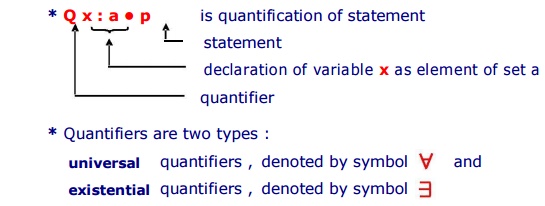
Universe of Discourse
The universe of discourse, also
called domain of discourse or universe.
This indicates :
a set of entities that the quantifiers deal.
entities can be set of real numbers, set of integers, set of all
cars on a parking lot, the set of all students in a classroom etc.
universe is thus the domain of the (individual) variables.
propositions in the predicate logic are statements on objects of a universe.
The universe is often left implicit
in practice, but it should be obvious from the context.
Examples:
About "natural numbers" forAll x, y (x < y or x = y or x > y), there is no need to be more
precise and say forAll x, y in N, because N
is implicit, being the universe of discourse.
About a property that holds for
natural numbers but not for real numbers, it is necessary to qualify what the
allowable values of x and y are.
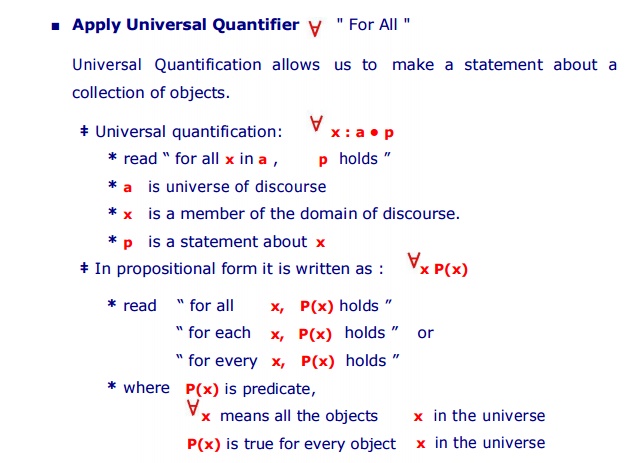
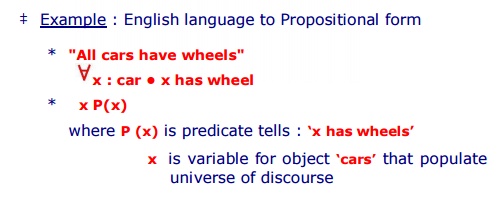
■
Apply Existential Quantifier
Existential Quantification allows
us to state that an object does exist without naming it.
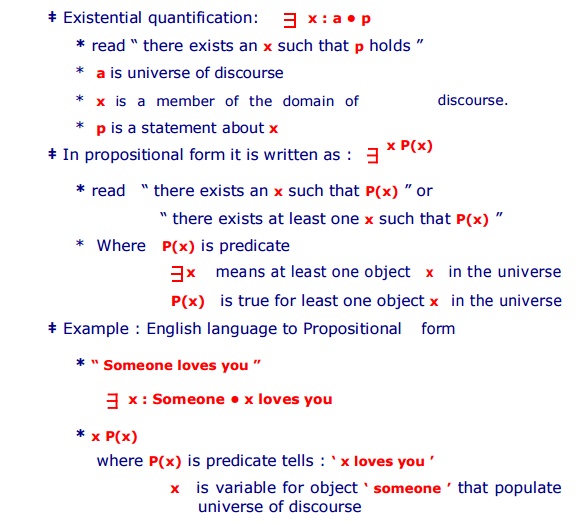
Formula
In mathematical logic, a formula is
a type of abstract object.
A token of a formula is a symbol or
string of symbols which may be interpreted as any meaningful unit in a formal
language.
‡ Terms
Defined recursively as variables,
or constants, or functions like f(t1, . . . , tn), where f is an n-ary function symbol, and t1, . . . , tn are terms. Applying predicates to terms
produces atomic formulas.
‡
Atomic formulas
An atomic formula (or simply atom)
is a formula with no deeper propositional structure, i.e., a formula that
contains no logical connectives or a formula that has no strict sub-formulas.
Atoms are
thus the simplest well-formed formulas of the logic.
Compound formulas are formed by combining the atomic formulas using the logical connectives.
Well-formed formula ("wiff") is a symbol or string of symbols (a formula) generated by the formal
grammar of a formal language.
An atomic formula is one of the
form :
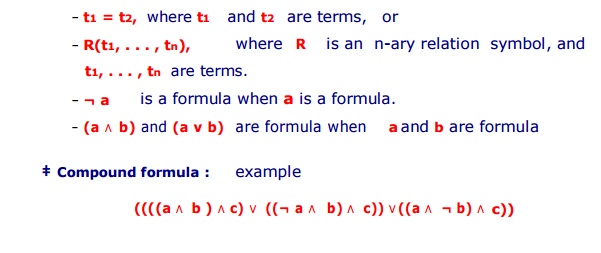
2. Representing “ IsA ” and “ Instance ” Relationships
Logic statements, containing subject, predicate, and object,
were
explained. Also stated, two
important attributes "instance"
and "isa", in a
hiera hical structure (Ref. Fig. Inheritable
KR).
Attributes “ IsA
” and “ Instance ” support property inheritance and play important role in
knowledge representation.
The ways these two attributes "instance" and "isa", are logically expressed are shown in the example below :
Example : A simple sentence like
"Joe is a musician"
Here "is a" (called IsA) is a way of expressing what
logically is called a class-instance
relationship between the subjects represented by the terms "Joe" and "musician".
"Joe" is an instance of the class of things called "musician".
"Joe" plays the role of instance,
"musician" plays the role of class in that sentence.
Note : In such a sentence, while for a human there
is no confusion,
but for computers each relationship
have to be defined explicitly.
This is specified as: [Joe] IsA [Musician]
i.e., [Instance] IsA [Class]
3. Computable Functions and Predicates
The objective is to define class of
functions C
computable in terms of F.
This is expressed as C { F }
is explained below using two examples :
"evaluate factorial n"
and (2) "expression for triangular functions". ■
Example 1 : A conditional expression to define
factorial n
ie n!
◊ Expression

values T or F for true and false respectively.
◊ The
value of ( p1 → e1, p2 → e2, . . . . . .pn → en ) is the value of the e corresponding to the first p
that has value T.
◊ The
expressions defining n! , n= 5, recursively are : n! = n x (n-1)! for n ≥ 1
5! = 1 x 2 x 3 x 4 x 5 = 120 0! = 1
The above definition incorporates
an instance that : if the product of no numbers ie 0! = 1 ,
then only, recursive relation (n + 1)! = (n+1) x n! works for n = 0 ◊ Use of the above conditional expressions to define functions n!
recursively is n! = ( n = 0 → 1, n ≠ 0 → n . (n – 1 ) ! )
◊ Example: Evaluate 2!
2! = ( 2 = 0 → 1, 2 ≠ 0 → 2 . ( 2 – 1 )! ) = 2 x 1!
= 2 x ( 1 = 0 → 1, 1 ≠ 0 → 1 . ( 1 – 1 )! ) = 2 x 1 x 0!
= 2 x 1 x ( 0 = 0 →
1, 0 ≠ 0 → 0 . ( 0 – 1 )! )
= 2 x 1 x 1
=2
■ Example 2 :
A conditional expression for
triangular functions
◊ The
graph of a well known triangular function is shown below
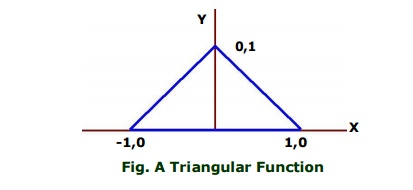
the conditional expressions for
triangular functions are
= (x < 0 →
-x , x ≥ 0 →
x)
the triangular function of the
above graph is represented by the conditional expression
tri (x) = (x ≤ -1 → 0, x ≤
0 → -x, x ≤
1 → x, x >1 →
0)
4. Resolution
Resolution is a procedure used in
proving that arguments which are expressible in predicate logic are correct.
Resolution is a procedure that
produces proofs by refutation or contradiction.
Resolution lead to refute a
theorem-proving technique for sentences in propositional logic and first-order
logic.
Resolution is a rule of inference.
Resolution is a computerized
theorem prover.
Resolution is so far only defined
for Propositional Logic. The strategy is that the Resolution techniques of
Propositional logic be adopted in Predicate Logic.
Related Topics